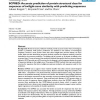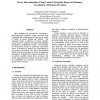48 search results - page 1 / 10 » Protein structural class prediction based on an improved sta... |
BMCBI
2008
13 years 4 months ago
2008
Background: A protein structural class (PSC) belongs to the most basic but important classification in protein structures. The prediction technique of protein structural class has...
BMCBI
2008
13 years 4 months ago
2008
Background: Amino acid sequence probability distributions, or profiles, have been used successfully to predict secondary structure and local structure in proteins. Profile models ...
BMCBI
2008
13 years 4 months ago
2008
Background: Protein structure prediction methods provide accurate results when a homologous protein is predicted, while poorer predictions are obtained in the absence of homologou...
JUCS
2010
13 years 3 months ago
2010
: When considering the prediction of a structural class for a protein as a classification problem, usually a classifier is based on a feature vector x ∈ Rn , where the features...
ISVD
2007
IEEE
13 years 11 months ago
2007
IEEE
Three strategies are presented for developing a knowledge-based statistical contact potential from computationally hydrated proteins that may be useful in studies of protein foldi...


